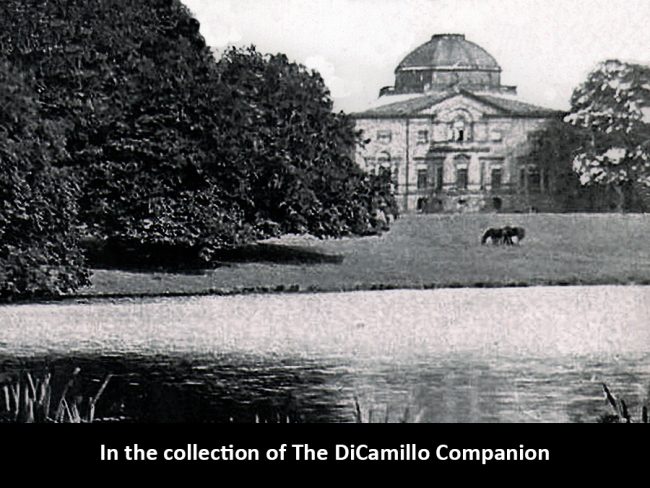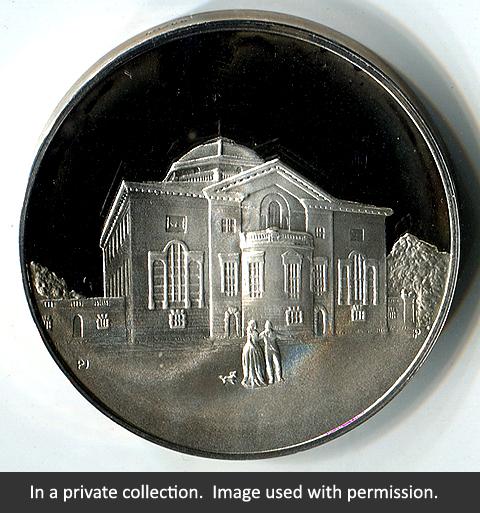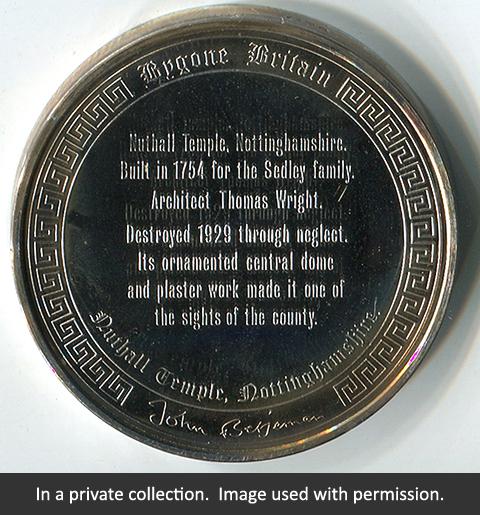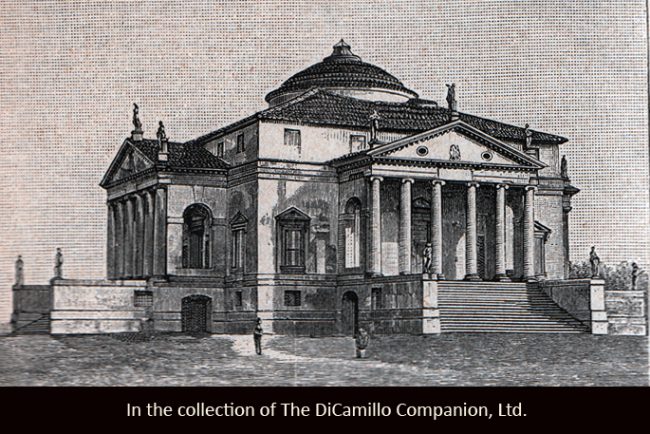
The house, from across the lake, from a circa 1901 postcard.

The house from a sterling silver proof medallion from John Betjeman's Bygone Britain series

The reverse of the Bygone Britain medallion

A 19th century engraving of the Villa Rotonda, Vicenza, upon which Nuthall was modeled.
Built / Designed For: Sir Charles Sedley
House & Family History: Nuthall Temple's central rotunda was a riot of Rococo plasterwork by Thomas Roberts of Oxford, who was paid the large sum of £1,000 (approximately £115,000 in 2012 values using real price commodity index) by Sir Charles Sidley for his work in 1765. James Wyatt's Music Room was in his Neoclassical style and had plasterwork probably executed by Joseph Rose. Nuthall passed from the Sidley family to the Vernons of Sudbury Hall and was put up for sale and purchased at auction by Robert Holden of Darley Hall, in 1817. It remained in the Holden family until 1929, when, no buyers being found, the house was sold for £800 to the housebreaking firm of J.H. Brough & Co. On July 31, 1929 the west wing was loaded with firelighters, sprinkled with paraffin, and set on fire in front of a large crowd. Nuthall Temple proved to be so well built that the demolition work was ultimately abandoned and the house was left a ruined shell until it was completely blown up in 1966 to make way for the M1 motorway). A number of the Nuthall Temple's architectural features, including the four exterior sphinxes and the exterior stairs, were purchased by the dealer A. Spero of London. The architect Paul Paget incorporated two stone sphinxes, steps, and balustrades from Nuthall at Templewood House, the 1938 house he built in Norfolk for Samuel Hoare, 1st Viscount Templewood. The Holden family kept the Nuthall land until the 1950s; the family ultimately decamped to Sibdon Castle in Shropshire. Nuthall Temple was one of five Palladian houses built in Britain based on Palladio's famous 16th century Villa Rotonda outside Vicenza (the others being Chiswick House, Greater London; Mereworth Castle, Kent; Henbury Hall, Cheshire; and Foots Cray Place, Kent [demolished]).
Collections: Wright of Derby (Joseph Wright) portraits and James Wyatt-designed chairs from Nuthall Temple are today in the collection at Sibdon Castle, where the Holden family moved after Nuthall was demolished. Nuthall also contained a very fine circa 1787 Wright of Derby view of a sunset on the coast near Salerno.
Comments: Giles Worsley, writing in "England's Lost Houses," states that Nuthall contained "one of the finest Rococo interiors in Britain" and goes on to say "it is very hard to think of another English Rococo house to rival it."
Architect: James Wyatt
Date: Circa 1778Vitruvius Britannicus: C. IV, pls. 56, 57, 1767.
Country Life: LIII, 570, 606, 1923.
Title: Treasure Houses of Britain, The - SOFTBACK
Author: Jackson-Stops, Gervase (Editor)
Year Published: 1985
Reference: pg. 393
Publisher: Washington, DC: National Gallery of Art (New Haven: Yale University Press)
ISBN: 0300035530
Book Type: Softback
Title: England's Lost Houses From the Archives of Country Life
Author: Worsley, Giles
Year Published: 2002
Reference: pg. 68
Publisher: London: Aurum Press
ISBN: 1854108204
Book Type: Hardback
Title: Biographical Dictionary of British Architects, 1600-1840, A - SOFTBACK
Author: Colvin, Howard
Year Published: 1995
Reference: pg. 1115
Publisher: New Haven: Yale University Press
ISBN: 0300072074
Book Type: Softback
Title: Destruction of the Country House, The
Author: Strong, Roy; Binney, Marcus; Harris, John
Year Published: 1974
Publisher: London: Thames & Hudson Ltd.
ISBN: 0500270052X
Book Type: Softback
Title: No Voice From the Hall: Early Memories of a Country House Snooper
Author: Harris, John
Year Published: 1998
Publisher: London: John Murray
ISBN: 0719555671
Book Type: Hardback
House Listed: Demolished
Park Listed: Destroyed
Past Seat / Home of: Sir Charles Sedley, 5th Bt., 17th century. Vernon family. Robert Holden, early 19th century; Robert Millington Holden, early 20th century.
Current Ownership Type: Demolished
Primary Current Ownership Use: Demolished
House Open to Public: No
Historic Houses Member: No